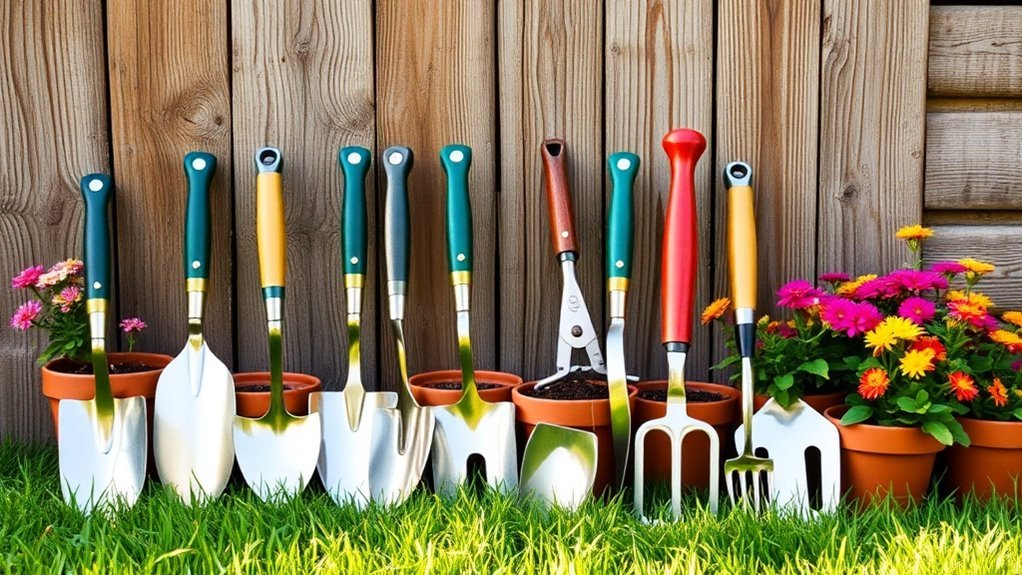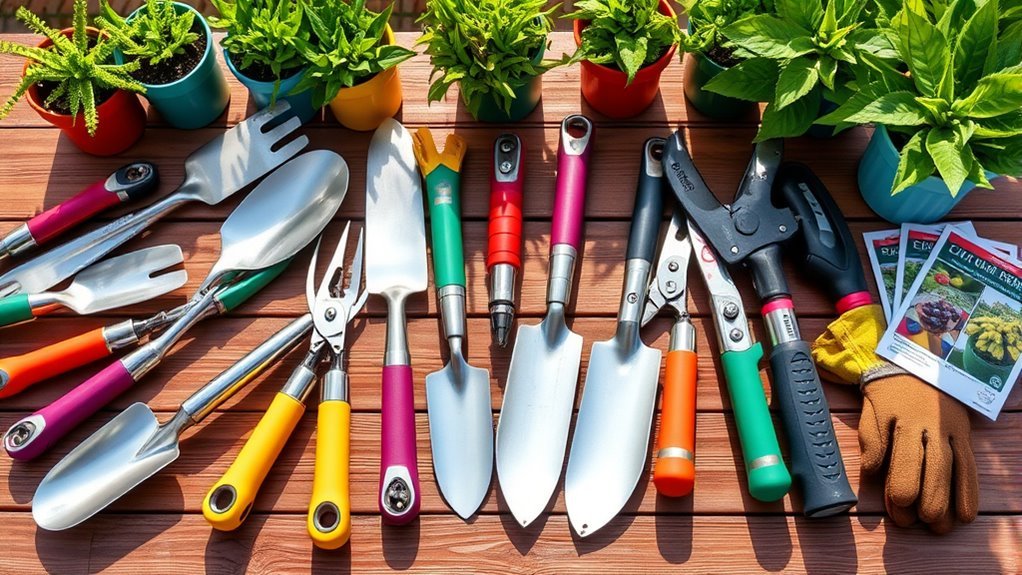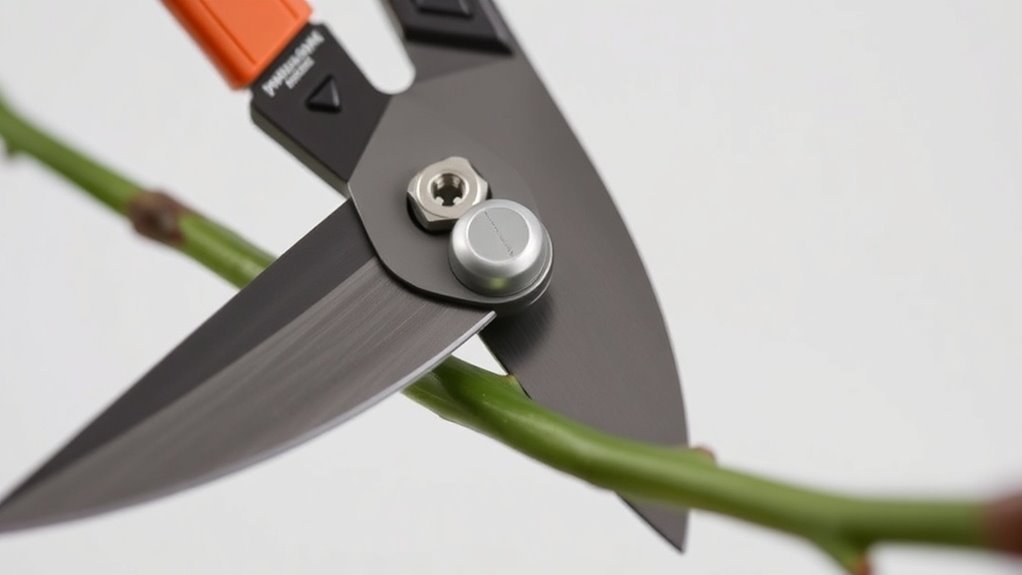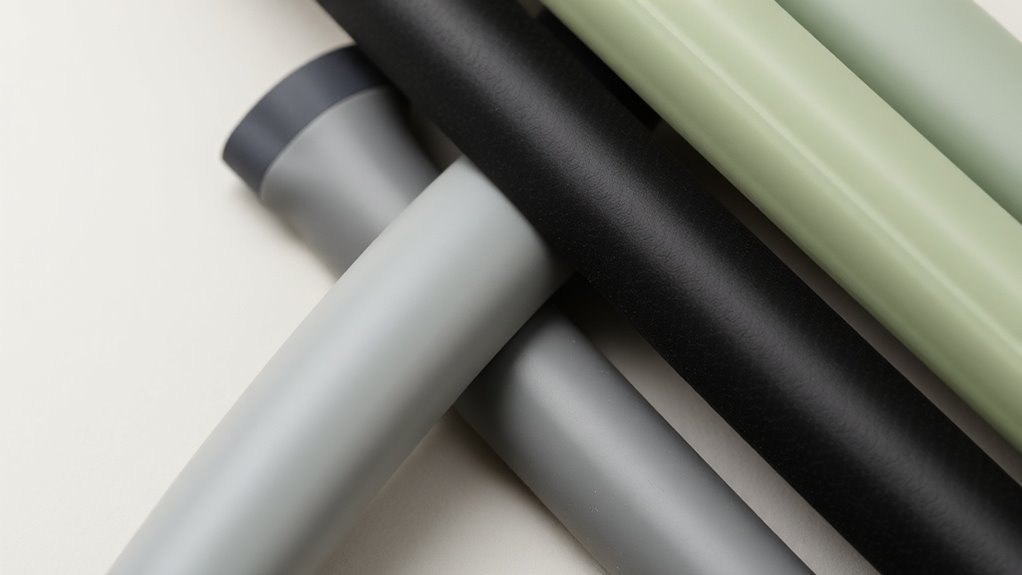Soil Preparation Tools and Their Functions
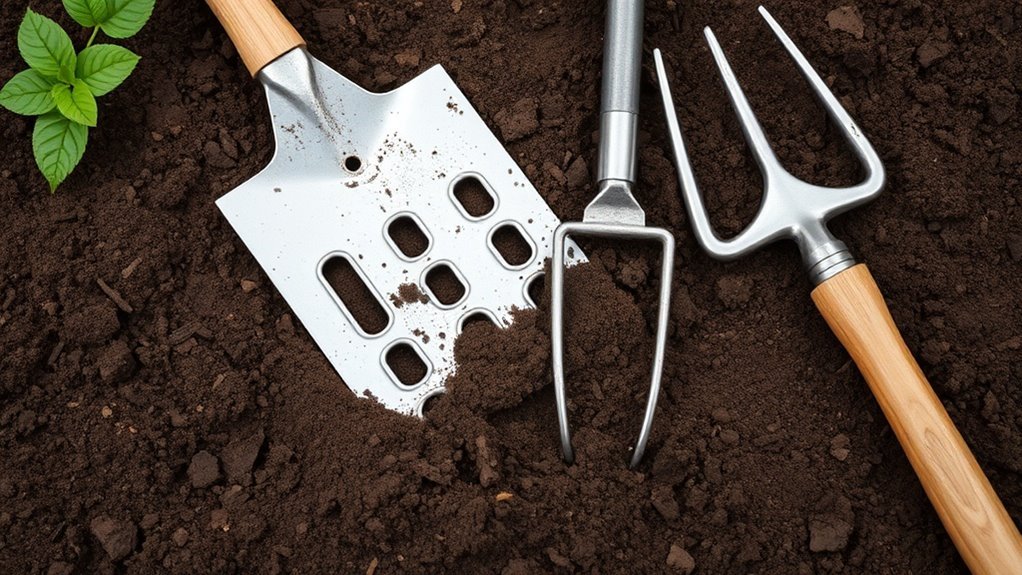
When prepping soil, having the right tools is essential. A garden fork loosens compacted soil, while a hand trowel helps with digging and transplanting. Hoes easily shape soil and control weeds, ensuring you create proper planting rows. If you’re tackling larger areas, consider using a tiller or tractor with a plow for efficiency. Don’t forget to incorporate soil amendments to improve fertility. There’s much more to discover about enhancing your gardening experience and soil health.
Key Takeaways
- Garden forks loosen compacted soil, mixing in compost and fertilizers to enhance nutrient availability.
- Hand trowels are versatile for digging, transplanting seedlings, and breaking up soil clumps effectively.
- Hoes shape soil, remove weeds, and create planting rows, ensuring proper plant spacing and structure.
- Tillers quickly break up compacted soil and incorporate organic matter, increasing efficiency for larger plots.
- Cultivators manage weeds and prepare fine seedbeds, promoting healthy plant growth in garden spaces.
Understanding Soil Types and Their Importance
When you start any gardening or landscaping project, understanding soil types is essential, as they directly influence plant health and growth.
Different soils—like sandy, clay, loamy, or silt—have unique properties that affect drainage, nutrient retention, and aeration. For instance, sandy soil drains quickly but can struggle with nutrient retention, while clay soil holds water and nutrients but may become compacted.
Different soil types—sandy, clay, loamy, and silt—impact drainage, nutrient retention, and plant health significantly.
Knowing your soil type helps you select the right plants and amend the soil accordingly. Testing your soil pH can also provide insights into its nutrient availability.
Ultimately, this foundational knowledge sets the stage for successful gardening, ensuring your plants thrive in an environment that suits their needs best.
Essential Hand Tools for Soil Preparation
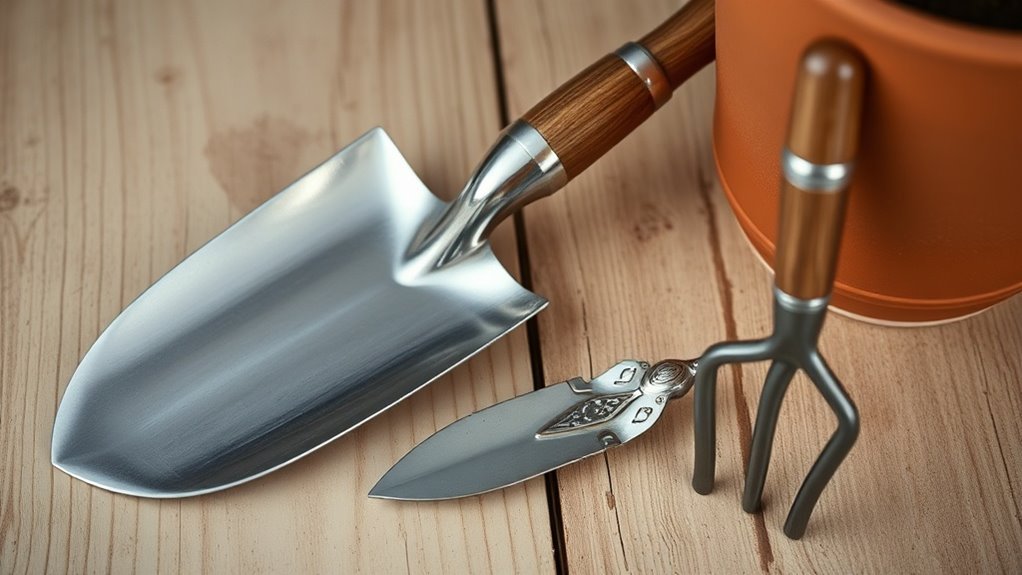
Having the right hand tools is essential for effective soil preparation in your garden. These tools help you cultivate, aerate, and improve soil quality effortlessly.
Here are three vital tools you shouldn’t overlook:
- Garden Fork: Perfect for loosening compact soil and mixing in compost or fertilizer.
- Hand Trowel: Ideal for digging, transplanting seedlings, and breaking up soil clumps.
- Hoe: Great for shaping soil, weeding, and creating planting rows.
With these essentials in your toolkit, you’ll find that preparing your soil becomes much easier and more productive. Using hand tools can also provide greater precision and control, which is crucial for successful soil preparation.
Each tool plays a specific role and can enhance your gardening experience, ensuring you set a strong foundation for healthy plants.
Don’t underestimate the power of these hand tools!
Mechanized Tools for Efficient Soil Tillage
While hand tools are invaluable for smaller gardens, mechanized tools can drastically increase efficiency, especially for larger plots.
Using tillers, you can break up compacted soil and incorporate organic matter quickly, saving you time and effort. Tractors equipped with plows can cover vast areas, turning over the soil to promote aeration and drain excess water.
Cultivators help keep weeds at bay and create a fine seedbed for planting. Plus, you’ll find that disk harrows smooth and level the soil, making it ready for crops.
The Role of Soil Amendments and Additives
Soil amendments and additives play an essential role in enhancing the health and fertility of your garden soil, ensuring your plants get the nutrients they need to thrive.
By integrating these materials into your soil, you can improve its structure, texture, and nutrient content. Here are three key types of amendments to take into account:
Enhancing your soil’s structure, texture, and nutrient content is vital for thriving plants. Consider key amendments for optimum growth.
- Organic Matter: Incorporating compost or well-rotted manure enriches soil, boosts microbial activity, and improves moisture retention.
- Mineral Additives: Utilizing lime or gypsum helps adjust pH levels and provides essential minerals for ideal plant growth.
- Mulch: Applying organic mulch around plants conserves moisture, regulates temperature, and suppresses weeds.
Techniques for Testing Soil Quality
Understanding the quality of your soil is essential for successful gardening, since it directly impacts plant growth.
One effective technique is the jar test, where you mix soil with water and let it settle to analyze the proportions of sand, silt, and clay.
Another method is pH testing; you can use simple kits or litmus paper to determine if your soil is acidic or alkaline.
Additionally, consider conducting a nutrient test, which reveals the levels of key elements like nitrogen, phosphorus, and potassium.
Finally, observe drainage and texture by digging a small hole to see how quickly water absorbs.
These tests help you identify any areas needing improvement, ensuring your plants thrive in a well-prepared environment.
Incorporating Mulch and Cover Crops
When it comes to enhancing your garden’s health, incorporating mulch and cover crops can make a big difference.
You’ll find that mulching helps retain moisture and suppress weeds, while selecting the right cover crops can improve soil structure and fertility. Additionally, using the right mulching tools can significantly enhance your garden maintenance efforts.
Let’s explore how to choose the best options for your specific needs.
Benefits of Mulching
Mulching is one of the simplest yet most effective ways to enhance your garden’s health. By adding a layer of mulch, you can protect your soil and plants while reaping several benefits:
- Weed Suppression: Mulch blocks sunlight, preventing weeds from sprouting and reducing maintenance time.
- Moisture Retention: It helps maintain soil moisture by reducing evaporation, so your plants stay hydrated longer.
- Soil Temperature Regulation: Mulch insulates the soil, keeping it cooler in summer and warmer in winter, which promotes healthy root growth.
Incorporating mulch not only improves the aesthetic appeal of your garden but also creates a healthier environment for your plants to thrive.
It’s a simple step that pays off big with minimal effort!
Selecting Cover Crops
Incorporating cover crops into your garden can greatly boost soil health and fertility. When selecting the right cover crops, consider your specific goals—whether it’s improving soil structure, fixing nitrogen, or suppressing weeds.
Some popular options include clover for nitrogen fixation, rye for erosion control, and vetch for its deep roots.
Timing’s also important; plant cover crops in the fall to protect soil during winter months, or in spring to enhance early growth.
Don’t forget to rotate your cover crops annually to prevent disease buildup and improve biodiversity.
Once you’ve chosen and planted your cover crops, you can till them under to enrich your soil before the main growing season begins, setting the stage for a flourishing garden.
Best Practices for Maintaining Soil Health
To maintain soil health effectively, you’ll want to implement a combination of practices that nurture and protect this essential resource.
Here are three best practices to take into account:
- Crop Rotation: Alternating crops helps break pest cycles and improves soil fertility, as different plants contribute varied nutrients.
- Organic Matter: Regularly adding organic materials, like compost or mulch, enriches the soil, boosts microbial activity, and enhances moisture retention.
- Minimal Tillage: Reducing tillage preserves soil structure and organisms, preventing erosion and compaction, which can harm soil health.
Questions
What Are Common Mistakes in Soil Preparation?
Common mistakes in soil preparation include not testing soil pH, over-tilling, neglecting organic matter, or ignoring drainage issues. You’ll want to guarantee proper aeration and nutrient balance for healthier plants and improved yields.
How Often Should Soil Be Tested?
You should test your soil at least once a year, but if you’re growing different crops or using new fertilizers, testing every season’s a great idea. It’ll help guarantee your soil stays healthy and productive.
Can Soil Prepare Itself Naturally Over Time?
Yes, soil can prepare itself naturally over time. Curiously, about 90% of the soil’s nutrients come from organic matter breakdown. However, you might still need to assist its health and fertility occasionally for best growth.
What Is the Impact of Soil Erosion on Preparation?
Soil erosion negatively impacts preparation by removing nutrients and organic matter, making it harder for soil to support healthy plants. Without proper care, you’ll find your gardening efforts hindered by depleted and unproductive soil.
How Do Weather Conditions Affect Soil Preparation Tools?
Did you know that over 75% of soil erosion happens during rainstorms? Weather conditions play an essential role in choosing your soil preparation tools, as excessive moisture can hinder their effectiveness and alter your overall strategy.
Conclusion
In preparing your soil, remember that understanding its type, using the right tools, and applying amendments are key. Embrace hand tools for precision, mechanized tools for efficiency, and techniques for testing to guarantee success. Incorporate mulch and cover crops to enrich your soil, and adopt best practices to maintain its health over time. By taking these steps, you’re not just cultivating your garden—you’re nurturing a sustainable environment for growth, both now and in the future.

